 |
|
| Table of Contents Previous Next | |
Chapter 2:
Economic Developments and Prospects
Highlights
- The Canadian economy recorded solid growth in 2005, largely supported by healthy increases in final domestic demand.
- Looking ahead, forecasters expect slightly stronger near-term growth than estimated at the time of the November 2005 Economic and Fiscal Update.
- Private sector forecasters have raised their forecasts for gross domestic product (GDP) inflation in 2006, largely because of unexpectedly strong growth in commodity prices in late 2005. As a result, the forecast level of nominal GDP in 2006 and 2007 is now over $20 billion higher than projected at the time of the Update.
- The risks to the Canadian economic outlook remain largely external, and include uncertainty about commodity prices, the risk of a sudden correction in U.S. house prices, and the risk that the Canadian dollar may appreciate further in response to adjustments to global imbalances.
Introduction
This chapter reviews recent economic developments and prospects. It establishes the economic-planning assumptions that underlie the Government’s budget plan and presents an assessment of risks and uncertainties associated with the economic outlook.
The Canadian economy recorded solid growth in 2005, largely supported by healthy increases in final domestic demand. Strong global growth in 2005 and rising demand for Canadian commodities contributed to a mid-year recovery in exports as the Canadian economy adjusted to past appreciations of the dollar.
Looking ahead, forecasters expect slightly stronger growth in 2006 than estimated at the time of the November 2005 Economic and Fiscal Update due to stronger than anticipated growth in the second half of 2005. The risks to the Canadian economic outlook remain largely external.
External Environment
Despite continued high oil prices, the global economic expansion maintained its momentum in 2005 and is expected to remain broadly on track over the near term. U.S. growth is expected to slow but continue to be strong. Growth in Japan and Europe is firming, and there is growing optimism that the improvement is sustainable. Overall, the International Monetary Fund (IMF) forecasts world real GDP growth (calculated at market exchange rates) of 3.6 per cent in 2006 and 3.4 per cent in 2007 (Table 2.1).
Table 2.1
Global Outlook for Real GDP Growth
|
|
||||
| 2004 | 2005 | 2006 | 2007 | |
|---|---|---|---|---|
|
|
||||
| (per cent) | ||||
| World1 | 4.0 | 3.4 | 3.6 | 3.4 |
| Japan | 2.3 | 2.7 | 2.8 | 2.1 |
| China | 10.1 | 9.9 | 9.5 | 9.0 |
| Euro area | 2.1 | 1.3 | 2.0 | 1.9 |
| United Kingdom | 3.1 | 1.8 | 2.5 | 2.7 |
| United States | 4.2 | 3.5 | 3.4 | 3.0 |
|
|
||||
| 1 World real GDP growth is calculated using market
exchange rates. Sources: IMF, World Economic Outlook (April 2006); Blue Chip Economic Indicators (April 2006). |
||||
United States
The U.S. economy slowed temporarily in the final quarter of 2005, as the end of automobile buyer incentive programs and surging gasoline prices in the aftermath of Hurricane Katrina took a toll on consumer spending and net exports weakened. Nevertheless, for 2005 as a whole, U.S. real GDP growth was a solid 3.5 per cent. Moreover, the economy bounced back strongly in the first quarter of 2006, reflecting rebounds in consumer spending, business investment and government spending as well as an acceleration in exports.
Going forward, U.S. growth is expected to ease during the second half of the year and into 2007, reflecting higher interest rates and a moderating housing market. Nevertheless, rising incomes and healthy corporate profits should help sustain growth in domestic demand, while a pickup in growth in its trading partners should translate into higher net export growth. Markets currently expect the Federal Reserve to complete its tightening cycle by mid-2006. Overall, U.S. private sector forecasters expect U.S. real GDP growth to average 3.4 per cent in 2006 and then ease to 3.0 per cent in 2007. The 2007 forecast is 0.2 percentage points lower than at the time of the November 2005 Economic and Fiscal Update.
Overseas Economies
In Japan, economic activity picked up strongly in late 2005. While Japanese growth has been supported by strong export growth, the expansion is increasingly being driven by final domestic demand. The IMF expects Japan’s recovery to remain firmly on track in 2006, as rising employment, strong corporate profits and a turnaround in bank credit growth continue to support domestic demand. Real GDP growth is expected to edge up to 2.8 per cent in 2006 before easing to 2.1 per cent in 2007.
In China, economic activity remains very strong thanks to high levels of investment and strong net exports. China recorded growth of about 10 per cent for the third consecutive year in 2005. The pace of expansion is projected to slow modestly in 2006 and 2007, as the contribution from external demand moderates and the government acts to slow investment growth.
The pattern of growth in the euro area has been relatively uneven but appears generally indicative of a strengthening expansion. Recent monthly indicators point to healthy activity so far in 2006. The recovery is expected to strengthen going forward, as last year’s depreciation of the euro and favourable financing conditions support business investment and external demand strengthens. Real GDP growth for the euro area is forecast to average 2.0 per cent in 2006 and 1.9 per cent in 2007, up from 1.3 per cent in 2005.
Economic growth in the United Kingdom slowed to 1.8 per cent in 2005, as a cooling housing market and higher energy prices brought about a slowdown in consumption. Nonetheless, business investment and export growth have remained steady, and as the factors that dampened activity in 2005 wane, real GDP growth is forecast to increase to 2.5 per cent in 2006 and 2.7 per cent in 2007.
Canadian Economy
In 2005, real GDP increased 2.9 per cent, the same pace as in 2004. Final domestic demand remained the engine of growth throughout the year, particularly consumer spending and business non-residential investment (Chart 2.1). At the same time, real exports improved, making growth more balanced. The current expansion is in its 15th year—the second longest in the postwar period (Chart 2.2).

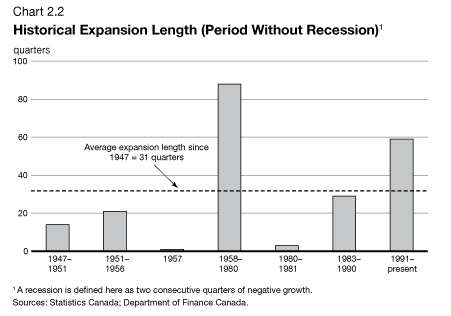
Developments in the world economy put upward pressure on the Canadian dollar in 2005, a continuation of the trend that began in late 2002. Global demand for commodities—particularly from rapid-growth regions like emerging Asia—has been strong in recent years, boosting global commodity prices. As a net exporter of commodities, Canada’s currency tends to rise when commodity prices rise. Global portfolio adjustments have also put upward pressure on the Canadian dollar in recent years in response to large and persistent U.S. current account deficits.
On a trade-weighted basis, the Canadian dollar has risen more than any other major currency since the beginning of 2003 (Chart 2.3). Moreover, the Canadian economy is more exposed to currency movements than other major economies, given Canada’s high ratio of total trade to GDP.
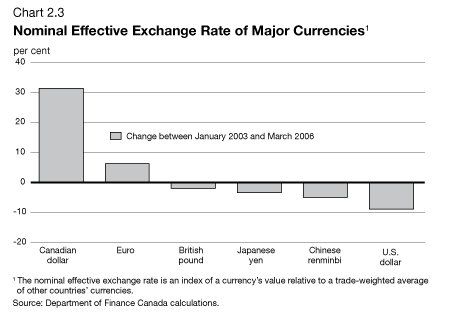
The appreciation of the Canadian dollar has posed a challenge to Canadian firms that are highly exposed to international trade. Employment in the manufacturing sector has declined by 173,900 since January 2003, around the time the dollar began to appreciate. Employment has been shifting away from manufacturing and into services in virtually all advanced industrial economies over the past 35 years (Chart 2.4). The previous weakness of the Canadian dollar masked this trend during the 1990s.
The overall economy has been adjusting well to the challenge posed by the rising dollar, with employment in all other industries growing by 989,100 since January 2003. The decline in Canadian manufacturing employment has been accompanied by strong employment growth in high-wage sectors such as construction, finance, insurance and real estate, professional and scientific services, and education.
In 2005, the Canadian economy created 254,700 new positions, all of which were full-time, and 2006 got off to a good start with a total of 101,500 new jobs in the first quarter (Chart 2.5). With strong job creation, the unemployment rate fell steadily through 2005 and sat at 6.3 per cent in March 2006, its lowest level since December 1974.
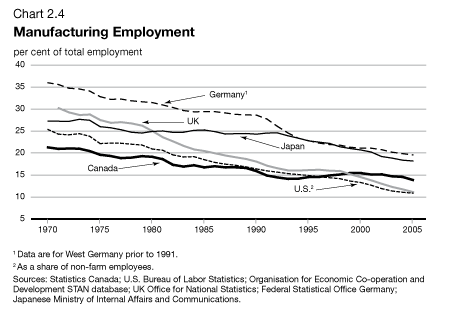
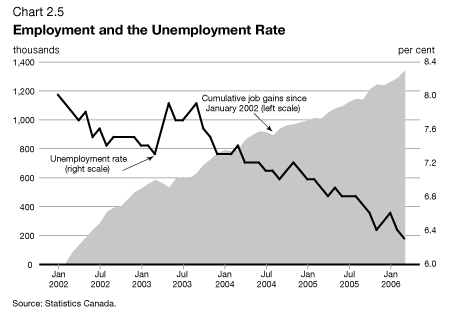
The strong pace of job creation has supported income growth and real consumer spending, which grew almost 4 per cent between the fourth quarters of 2004 and 2005. Durable and semi-durable goods consumption have been particularly strong. Strong income growth and low mortgage rates have supported residential investment growth, which grew by more than 3 per cent in 2005.
Strong domestic demand, the recovery in exports and higher commodity prices have helped maintain robust corporate profit growth. In the fourth quarter of 2005, corporate profits were more than 13 per cent above their level one year earlier. Total corporate profits in Canada now stand at 14.6 per cent of GDP, the highest level on record (Chart 2.6).
Reduced costs of imported machinery and equipment (M&E) stemming from the stronger Canadian dollar have helped to support strong growth in investment. Real investment in M&E was 10.7 per cent higher in the fourth quarter of 2005 than one year earlier.
Engineering construction in the oil and gas sector has been stimulated by higher energy prices and profits, contributing to a strengthening in non-residential construction. Investment in the oil and gas sector is at its highest share of GDP in 15 years.
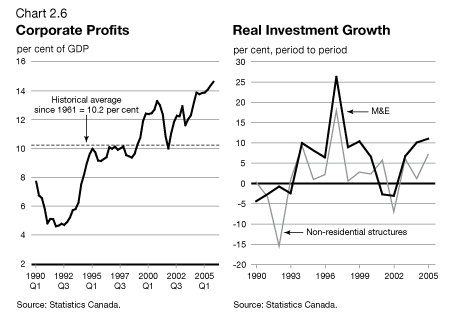
After growing an average of only 0.3 per cent per year in 2003 and 2004, productivity growth rebounded in 2005, growing at a rate similar to the 2.1 per cent recorded over the 1997–2002 period.
While Consumer Price Index (CPI) inflation increased following energy price increases last fall, it subsided toward the end of 2005 as energy prices eased. In March, total CPI inflation was 2.2 per cent (year over year), with core inflation at 1.7 per cent. Core inflation has remained stable and below the 2-per-cent mid-point of the inflation target range for over two years. Later this year, the Government of Canada and the Bank of Canada will announce a new inflation target agreement.
The Bank of Canada has raised interest rates by 150 basis points since September 2005, reflecting its view that the Canadian economy is operating at, or just above, its production capacity and its expectation that the economy will continue to grow at a healthy pace in 2006 and 2007.
Private Sector Economic Forecasts
The Department of Finance Canada surveys 18 private sector economic forecasters on a quarterly basis regarding their outlook for the Canadian economy. This survey forms the basis for economic assumptions that underlie the fiscal projections for the budget. In addition, the Minister of Finance meets with a group of private sector economists to discuss Canada’s economic outlook and the risks and uncertainties associated with the outlook.
The economic forecasts reported here reflect the survey of private sector forecasters conducted by the Department in March following the release of the 2005 fourth-quarter National Income and Expenditure Accounts by Statistics Canada on February 28.
Canadian real GDP growth over the second half of 2005 was slightly stronger than private sector forecasters had anticipated at the time of the November 2005 Economic and Fiscal Update, leading forecasters to revise up their outlook for 2006 slightly from 2.9 per cent to 3.0 per cent. Forecasters now expect the economy to grow by 2.7 per cent in 2007, down from 3.1 per cent in the Update. The moderation in growth in 2007 likely reflects revisions to private sector forecasters’ views about U.S. economic growth as well as upward revisions to their outlook for the Canada-U.S. exchange rate over the same period.
Private sector forecasters have raised their forecasts for GDP inflation in 2006 largely because of unexpectedly strong growth in commodity prices in late 2005. Forecasters now expect GDP inflation of 2.9 per cent in 2006, up from 2.2 per cent in the November Update. Forecasters have revised their outlook for GDP inflation in 2007 to 1.8 per cent from 1.6 per cent in November.
As a result, the outlook for nominal GDP growth in 2006 has been revised up from 5.2 per cent in the November Update to 6.0 per cent. The upward revision to GDP inflation in 2007 almost entirely offsets the downward revision to real GDP growth in the year, resulting in nominal GDP growth of 4.6 per cent, which is only marginally lower than projected at the time of the Update (4.7 per cent). The forecast level of nominal GDP in 2006 and 2007 is now over $20 billion higher than projected at the time of the Update (Chart 2.7). Compared to the 2005 budget, the nominal GDP forecast is $29 billion higher in 2006 and $25 billion higher in 2007, after adjusting for historical revisions.
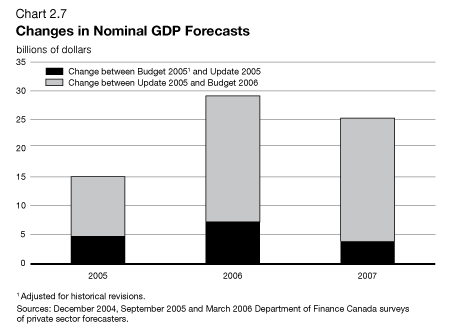
In the November Update, private sector forecasters expected a gradual pace of monetary tightening, resulting in short-term interest rates averaging 3.4 per cent in 2006 and 4.1 per cent in 2007. The current private sector outlook reflects an accelerated pace of tightening with short-term rates averaging 4.0 per cent in 2006. However, no further monetary tightening is anticipated in 2007 as short-term interest rates are expected to average 4.1 per cent in 2007, unchanged from the Update.
The outlook for long-term interest rates has also been revised since the Update. Interest rates on 10-year government bonds are expected to average 4.4 per cent in 2006, unchanged from those expected at the time of the Update. However, for 2007, long-term rates are expected to average 4.5 per cent, approximately 60 basis points lower than levels anticipated in the Update, reflecting lower expectations of U.S. long-term rates.
Private sector forecasters expect the labour market in Canada to remain healthy. The unemployment rate is forecast to average 6.6 per cent in 2006 and 2007, lower than the 6.8 per cent forecast over the same period in the Update. Forecasters have raised their outlook for employment growth in 2006 from 1.3 per cent in the Update to 1.5 per cent. Employment growth is expected to slow somewhat from this strong pace to 1.2 per cent in 2007, slightly lower than anticipated at the time of the Update (1.4 per cent).
Table 2.2
Evolution of the Average Private Sector Forecast for Key Indicators
|
|
|||
|---|---|---|---|
| 2005 | 2006 | 2007 | |
|
|
|||
| (per cent, unless otherwise indicated) | |||
| Real GDP growth | |||
| February 2005 budget | 2.9 | 3.1 | 3.1 |
| November 2005 Economic and Fiscal Update |
2.8 | 2.9 | 3.1 |
| May 2006 budget | 2.9 | 3.0 | 2.7 |
| GDP inflation | |||
| February 2005 budget | 2.0 | 1.9 | 1.8 |
| November 2005 Economic and Fiscal Update |
2.4 | 2.2 | 1.6 |
| May 2006 budget | 3.1 | 2.9 | 1.8 |
| Nominal GDP growth | |||
| February 2005 budget | 4.9 | 5.0 | 5.0 |
| November 2005 Economic and Fiscal Update |
5.3 | 5.2 | 4.7 |
| May 2006 budget | 6.1 | 6.0 | 4.6 |
| Nominal GDP level (billions of dollars) | |||
| February 2005 budget1 | 1,354 | 1,422 | 1,492 |
| November 2005 Economic and Fiscal Update | 1,358 | 1,429 | 1,496 |
| May 2006 budget | 1,369 | 1,451 | 1,517 |
| 3-month treasury bill rate | |||
| February 2005 budget | 2.7 | 3.5 | 4.5 |
| November 2005 Economic and Fiscal Update | 2.7 | 3.4 | 4.1 |
| May 2006 budget | 2.7 | 4.0 | 4.1 |
| 10-year government bond rate | |||
| February 2005 budget | 4.6 | 5.1 | 5.5 |
| November 2005 Economic and Fiscal Update | 4.0 | 4.4 | 5.1 |
| May 2006 budget | 4.1 | 4.4 | 4.5 |
| Unemployment rate | |||
| February 2005 budget | 7.2 | 7.0 | 6.9 |
| November 2005 Economic and Fiscal Update | 6.8 | 6.8 | 6.8 |
| May 2006 budget | 6.8 | 6.6 | 6.6 |
| Employment growth | |||
| February 2005 budget | 1.4 | 1.5 | 1.5 |
| November 2005 Economic and Fiscal Update | 1.3 | 1.3 | 1.4 |
| May 2006 budget | 1.4 | 1.5 | 1.2 |
| Addendum: | |||
| U.S. real GDP growth | |||
| February 2005 budget | 3.6 | 3.4 | n/a |
| November 2005 Economic and Fiscal Update | 3.5 | 3.3 | 3.2 |
| May 2006 budget | 3.5 | 3.4 | 3.0 |
|
|
|||
| 1 Nominal GDP levels have been adjusted to reflect May
2005 revisions to Canada’s National Income and Expenditure Accounts. Sources: December 2004, September 2005 and March 2006 Department of Finance Canada surveys of private sector forecasters. U.S. real GDP growth: January 2005, October 2005 and April 2006 Blue Chip Economic Indicators. |
|||
Risks to the Economic Outlook
The risks to the Canadian outlook remain largely external. They are uncertainty about commodity prices, the risk of a sharp correction in U.S. house prices, and the risk that the Canadian dollar may appreciate further in response to adjustments to global imbalances. There is also a concern about the potential economic impacts of an influenza pandemic.
Commodity Prices
Prices for many commodities remain high and volatile. Strong demand growth, particularly in developing Asian economies, combined with tight supply conditions, has led to significantly higher prices of energy commodities and industrial metals in recent years. From late 2002 to the first quarter of 2006, crude oil prices rose almost 120 per cent. Natural gas prices are up over 80 per cent over the same period, despite a recent sharp decline. Prices for key Canadian industrial metals saw even stronger gains, with price increases for copper, nickel, zinc and aluminum averaging almost 150 per cent.
Higher commodity prices boost incomes and ultimately lead to higher investment, employment and output in the commodity sector.
Higher commodity prices also tend to boost the Canadian dollar, which can dampen growth in manufacturing and other export-oriented industries. Further, higher prices for oil and natural gas translate directly into reduced purchasing power of consumers both domestically and in our trading partners, reducing growth in real consumer spending and exports. Strong demand and limited capacity mean that there is a near-term risk of further oil and natural gas price increases, which would pose a downside risk to near-term real GDP growth in Canada and the United States. Oil prices also remain vulnerable to geopolitical developments.
At the same time, energy and industrial metals prices remain well above historical trend levels, in real terms. For example, real crude oil prices are currently over 2.5 times their average level over the last six decades (Chart 2.8), while real natural gas prices are nearly four times their historical average over the same period. Similarly, real industrial metals prices are likely also above historical trend levels. While private sector forecasters expect some declines in both energy and non-energy commodity prices, there is a risk that they could decline more than expected. This would mean lower-than-expected nominal GDP over the medium term.
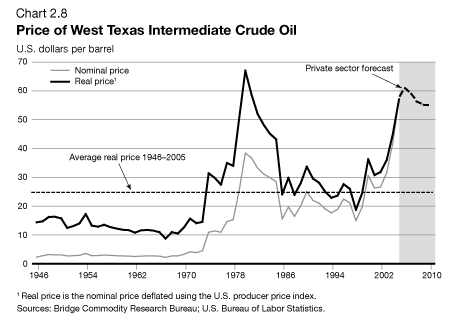
U.S. House Prices
Real U.S. house prices have increased at a rapid rate in the past few years (Chart 2.9). While recent price gains have been less pronounced than those recorded in other countries such as the United Kingdom and Australia, their duration and size have far surpassed that of previous U.S. housing booms. House prices have increased significantly in Canada as well, although the rise has been less pronounced than in the U.S. and has partly reflected a recovery from depressed levels in the mid-1990s.
The strength in U.S. house prices has provided an important boost to economic activity in recent years. Rising house prices have stimulated housing construction and boosted employment in housing-related industries. Households’ willingness and ability to spend accumulated housing wealth—through equity withdrawals and mortgage refinancing—have been a major contributor to the growth in consumer expenditures.
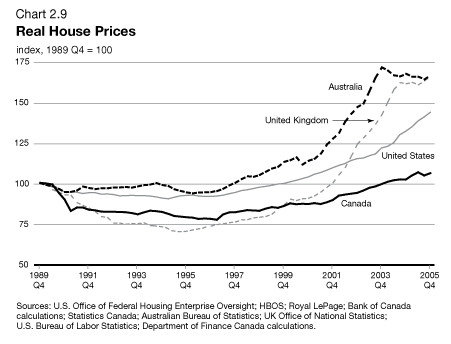
U.S. housing market indicators are already showing signs of cooling, owing to rising interest rates in the U.S., as monetary policy aims to gradually slow domestic demand to avoid an overheating economy. U.S. house price growth is expected to gradually slow from its recent fast pace, contributing to the weaker 2007 growth outlook predicted by private sector forecasters. A more abrupt adjustment in house prices would imply weaker consumer spending growth than expected. A slower U.S. economy would have negative implications for the Canadian economy as well.
Resolution of Global Imbalances
Global imbalances continued to widen in 2005 (Chart 2.10). The U.S. current account deficit grew to 6.4 per cent of U.S. GDP and almost 2 per cent of world GDP, matched by growing surpluses in China, oil-exporting countries and Germany. Current account surpluses remained large in Japan and the rest of emerging Asia as well.
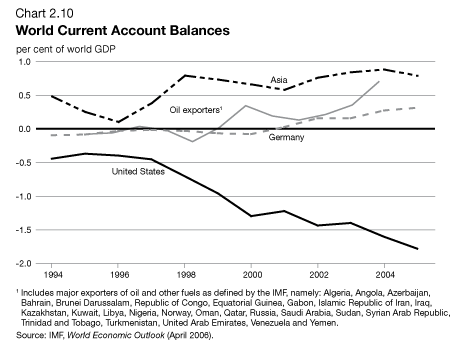
The widening of global imbalances in recent years reflects changes in saving and investment in the U.S. and the rest of the world. In China and (to a lesser extent) the rest of emerging Asia, active currency management has boosted saving and has led to a massive accumulation of foreign reserves. Surging oil prices since 2002 have boosted saving in oil-exporting economies, such as those in the Organization of the Petroleum Exporting Countries (OPEC), Russia and Norway. Investment as a share of GDP in the rest of the world has fallen, reflecting economic weakness in Germany and Japan and continued low investment in emerging Asia (excluding China) since the Asian financial crisis of 1997–98. The combination of rising saving and weak investment in the rest of the world has helped push global long-term interest rates down.
Low long-term interest rates have boosted house prices and consumption in the U.S., which has in turn pushed the personal savings rate down. At the same time, the federal budget has shifted from surpluses to large deficits. In this environment, the fall in the U.S. dollar since the beginning of 2002 has not been sufficient to reduce imbalances.
Greater currency flexibility in emerging Asia, stronger overseas growth and a reduction in the U.S. fiscal deficit would all help to correct global imbalances. However, there is a risk that the main channel of adjustment could be a further depreciation of the U.S. dollar against floating currencies such as the Canadian dollar.
Influenza Pandemic
Since January 2004, widespread outbreaks of the H5N1 influenza virus in birds have been associated with around 200 human cases and more than 100 deaths in Asia. Most human cases have been linked to direct contact with infected poultry. There is a concern that H5N1 could mutate or mix with an existing human influenza virus to create a new strain that would be easily transmissible among humans and to which humans would have no immunity. Such a strain could cause a pandemic.
While there is currently no indication that H5N1 is becoming transmissible, a pandemic at some future date could have economic consequences.
A severe pandemic like that of 1918 would likely lead to a brief but noticeable reduction in GDP growth as a result of higher worker absenteeism and reduced spending in some sectors. Some expenditures would, however, be reallocated across sectors, lessening the impact on total GDP. Growth could be expected to rebound sharply immediately following the pandemic as absenteeism returns to normal levels and spending occurs that had been delayed because of the pandemic. A mild pandemic like those of 1957 and 1968 would likely have very small economic impacts.
| The Economic Impacts of Past Influenza Pandemics and
SARS
The 1918 Pandemic The 1918 influenza pandemic was far more severe than any other on record. About 20 per cent of Americans fell ill between September 1918 and January 1919, with about half the cases occurring in October. About 0.5 per cent of the U.S. population died, mostly from pneumonia complications. Mortality was concentrated among persons aged 20 to 40. The increase in mortality in the province of Ontario was similar to that in the United States in 1918. Declines in U.S. industrial production in the fall of 1918 suggest that the pandemic reduced annual 1918 U.S. GDP by up to 0.5 per cent. Small impacts are apparent in passenger rail and transit use. Retail sales, external trade, financial markets and bankruptcies appear to have been unaffected. Similar data are not available for Canada for this period. The 1957 and 1968 Pandemics The 1957 pandemic struck North America in the fall of 1957, with about half the cases occurring in October. About 35 per cent of the population fell ill and about 0.04 per cent died, with deaths concentrated among the very young and very old. The 1968 pandemic reached North America in December. It was the mildest of the three pandemics in the 20th century, with population mortality of 0.02 per cent. The 1957 pandemic pushed the Canadian illness absenteeism rate up by 3.1 percentage points in October 1957. Both the 1957 and 1968 pandemics had very small impacts on the Canadian economy. SARS Severe acute respiratory syndrome (SARS) was an atypical pneumonia that appeared in Southeast Asia in late 2002 and early 2003 and spread to a number of other countries in the spring. The World Health Organization estimates that 8,096 people were infected, of whom 774 died. Canada was the most affected non-Asian country with 251 cases and 43 deaths, most of these in Toronto. SARS had a significant impact on air travel to affected locations. Hong Kong and Singapore were particularly vulnerable owing to the importance of tourism to their economies. Air travel reductions stemming from SARS and the start of the second Gulf War caused Hong Kong and Singapore GDP to contract in the second quarter of 2003. Goods trade and retail sales were largely unaffected. Reduced air travel also affected Canada, with negative impacts on the accommodation industry, particularly in Toronto. Travel and accommodation impacts reduced Canadian annual GDP by about 0.03 per cent in 2003. |
Note: This chapter incorporates data available up to April 26, 2006. Figures in this chapter are at annual rates unless otherwise noted.
| Table of Contents Previous Next |
|
|
|||||
| Last Updated: 2006-05-02 | |||||